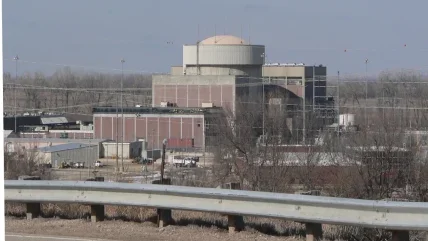
THE FORT CALHOUN NUCLEAR GENERATING Station, located next to the Missouri River in the US state of Nebraska, is a single unit PWR. It began construction in 1966 and entered commercial operation in August 1973. Fort Calhoun was officially shut down on 24 October 2016, after 43 years of operation.
In 2019 Omaha Public Power District, the plant’s owner/ operator, signed a contract with nuclear services company EnergySolutions, to provide technical support for the safe, efficient decommissioning of Fort Calhoun. OPPD’s board
of directors also endorsed use of an accelerated method of decontamination and deconstruction called DECON. The option is expected to have the site largely dismantled in the mid-2020s, saving ratepayers around $200 million.
OPPD employees are leading the decommissioning work, while EnergySolutions personnel provide technical support and project expertise on decommissioning management and radiological waste services.
Since Fort Calhoun shut down, OPPD employees have worked towards moving the spent fuel from the used fuel pool into dry casks and onto the independent spent fuel storage installation (ISFSI).
Under a 2018 contract with OPPD, Orano was contracted to expand Fort Calhoun’s existing Nuhoms® dry storage system and perform all pool-to-pad transfer services. The project kicked off in earnest in mid-October 2019, according to OPPD. In total, 32 Nuhoms horizontal dry storage modules were cast in place on site in only eight months, using local providers for concrete provision, machine shop fabrication and other project services.
In North Carolina, Orano TN manufactured 30 stainless steel canisters, which were shipped to Nebraska following inspection. Once they arrived on site they were re- inspected. The containers were submerged in the spent fuel pool using a heavy lifting crane and were loaded with spent fuel by trained operators. Specialist cameras enabled the work to be monitored continuously. Once loaded, the canisters were removed from the pool, shielded and closed with steel lids. They were then vacuum dried, welded shut and inspected again.
Sealed canisters were placed in a transport cask and loaded on to heavy equipment transport. Casks were transported to the IFSFI under close watch and tight controls. They were seated into the horizontal dry storage modules and the shielding panel was secured, completing the storage process.
Orano also completed an extensive inspection of the emptied used fuel pool, using underwater cameras and radiation detectors, to ensure that all fuel debris had been collected and loaded into the canisters.
The final spent fuel bundle was placed into its container on 8 May and the cask was stored in its storage module five days later.
Orano says the team achieved an average four-day loading cycle for each used fuel canister with a total project dose less below target.
Amir Vexler, US president of Orano TN, praised the teams’ coordination, initiative and professionalism, which overcame some unusual challenges, including “flooding from the Missouri river during the training and dry run sessions in 2019, severe winter storms, and implementing pandemic safety requirements.”
OPPD says crossing this spent fuel storage milestone helps enable the next phases of the site’s decontamination and deconstruction, which will include the removal of plant components and eventual demolition of some structures. Current schedules project decommissioning to be substantially complete around 2025. However, the spent nuclear fuel will remain on site in the ISFSI until the federal government fulfils its obligation to transport the fuel to an interim or permanent disposal site. The ISFSI will remain guarded and monitored around the clock, with regular inspections and sampling to ensure it remains within regulatory compliance.
“Completing this project safely, on-time and on-budget required a true collaborative effort between OPPD and Orano TN,” says Tim Uehling, senior director, Fort Calhoun station decommissioning. “This major accomplishment demonstrates the care and commitment of all those involved throughout the project. OPPD’s customer-owners can be assured of the continued safe, secure storage of fuel in the robust dry storage system provided by Orano TN.”
All photos courtesy Omaha Public Power District






